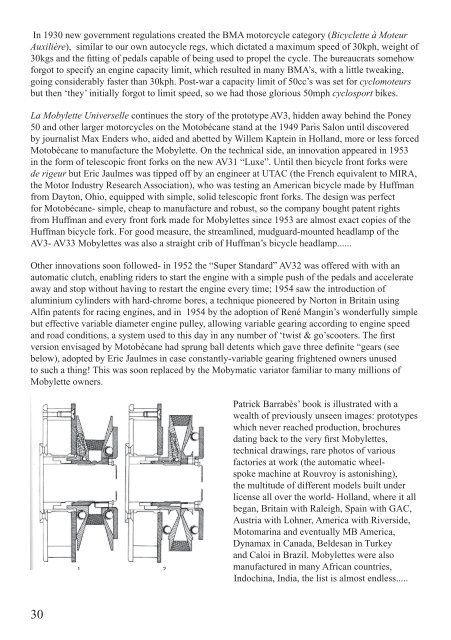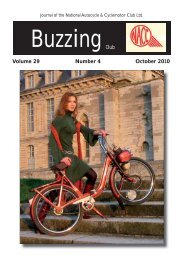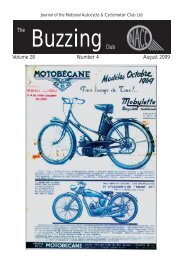Book review- la Mobylette Universelle - National Autocycle and ...
Book review- la Mobylette Universelle - National Autocycle and ...
Book review- la Mobylette Universelle - National Autocycle and ...
You also want an ePaper? Increase the reach of your titles
YUMPU automatically turns print PDFs into web optimized ePapers that Google loves.
In 1930 new government regu<strong>la</strong>tions created the BMA motorcycle category (Bicyclette à Moteur<br />
Auxilière), simi<strong>la</strong>r to our own autocycle regs, which dictated a maximum speed of 30kph, weight of<br />
30kgs <strong>and</strong> the fi tting of pedals capable of being used to propel the cycle. The bureaucrats somehow<br />
forgot to specify an engine capacity limit, which resulted in many BMA’s, with a little tweaking,<br />
going considerably faster than 30kph. Post-war a capacity limit of 50cc’s was set for cyclomoteurs<br />
but then ‘they’ initially forgot to limit speed, so we had those glorious 50mph cyclosport bikes.<br />
La <strong>Mobylette</strong> <strong>Universelle</strong> continues the story of the prototype AV3, hidden away behind the Poney<br />
50 <strong>and</strong> other <strong>la</strong>rger motorcycles on the Motobécane st<strong>and</strong> at the 1949 Paris Salon until discovered<br />
by journalist Max Enders who, aided <strong>and</strong> abetted by Willem Kaptein in Hol<strong>la</strong>nd, more or less forced<br />
Motobécane to manufacture the <strong>Mobylette</strong>. On the technical side, an innovation appeared in 1953<br />
in the form of telescopic front forks on the new AV31 “Luxe”. Until then bicycle front forks were<br />
de rigeur but Eric Jaulmes was tipped off by an engineer at UTAC (the French equivalent to MIRA,<br />
the Motor Industry Research Association), who was testing an American bicycle made by Huffman<br />
from Dayton, Ohio, equipped with simple, solid telescopic front forks. The design was perfect<br />
for Motobécane- simple, cheap to manufacture <strong>and</strong> robust, so the company bought patent rights<br />
from Huffman <strong>and</strong> every front fork made for <strong>Mobylette</strong>s since 1953 are almost exact copies of the<br />
Huffman bicycle fork. For good measure, the streamlined, mudguard-mounted head<strong>la</strong>mp of the<br />
AV3- AV33 <strong>Mobylette</strong>s was also a straight crib of Huffman’s bicycle head<strong>la</strong>mp......<br />
Other innovations soon followed- in 1952 the “Super St<strong>and</strong>ard” AV32 was offered with with an<br />
automatic clutch, enabling riders to start the engine with a simple push of the pedals <strong>and</strong> accelerate<br />
away <strong>and</strong> stop without having to restart the engine every time; 1954 saw the introduction of<br />
aluminium cylinders with hard-chrome bores, a technique pioneered by Norton in Britain using<br />
Alfi n patents for racing engines, <strong>and</strong> in 1954 by the adoption of René Mangin’s wonderfully simple<br />
but effective variable diameter engine pulley, allowing variable gearing according to engine speed<br />
<strong>and</strong> road conditions, a system used to this day in any number of ‘twist & go’scooters. The fi rst<br />
version envisaged by Motobécane had sprung ball detents which gave three defi nite “gears (see<br />
below), adopted by Eric Jaulmes in case constantly-variable gearing frightened owners unused<br />
to such a thing! This was soon rep<strong>la</strong>ced by the Mobymatic variator familiar to many millions of<br />
<strong>Mobylette</strong> owners.<br />
30<br />
Patrick Barrabès’ book is illustrated with a<br />
wealth of previously unseen images: prototypes<br />
which never reached production, brochures<br />
dating back to the very fi rst <strong>Mobylette</strong>s,<br />
technical drawings, rare photos of various<br />
factories at work (the automatic wheelspoke<br />
machine at Rouvroy is astonishing),<br />
the multitude of different models built under<br />
license all over the world- Hol<strong>la</strong>nd, where it all<br />
began, Britain with Raleigh, Spain with GAC,<br />
Austria with Lohner, America with Riverside,<br />
Motomarina <strong>and</strong> eventually MB America,<br />
Dynamax in Canada, Beldesan in Turkey<br />
<strong>and</strong> Caloi in Brazil. <strong>Mobylette</strong>s were also<br />
manufactured in many African countries,<br />
Indochina, India, the list is almost endless.....






